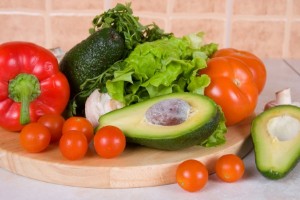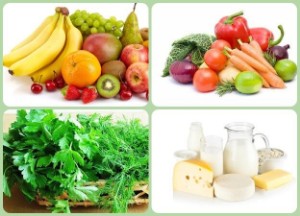13 foods that help improve digestion according to scientists
 The gastrointestinal tract is one of the main systems in the human body. It is responsible for the digestion and assimilation of all nutrients coming from food, and the excretion of processed waste products.
The gastrointestinal tract is one of the main systems in the human body. It is responsible for the digestion and assimilation of all nutrients coming from food, and the excretion of processed waste products.
Improper nutrition can cause many digestive problems: from banal dyspeptic disorders (heartburn, bloating, nausea, stool disorders) to serious diseases requiring medical attention (gastritis, duodenitis, ulcerative colitis, GERD, etc.).
It is necessary to control your diet and consume more useful products. This will not only prevent, but also alleviate a number of pathologies, as well as improve the general condition of the body due to the accelerated elimination of toxic metabolites.
Below are 13 foods that improve the functioning of the stomach and intestines, contributing to good digestion.
1. Fermented dairy products
 Fermented dairy products contain a lot of beneficial bacteria, yeast, proteins, minerals and essential amino acids that cannot be synthesized by the body on their own. Such products are well digested, as they have already been partially broken down by bacterial agents.
Fermented dairy products contain a lot of beneficial bacteria, yeast, proteins, minerals and essential amino acids that cannot be synthesized by the body on their own. Such products are well digested, as they have already been partially broken down by bacterial agents.
According to scientists , microorganisms in fermented dairy products stimulate secretory activity (increase the production of digestive juices), prevent rotting processes (these processes lead to bloating and stool disorders), normalize peristalsis.
Russian biologist I. I. Mechnikov believed that one of the main causes of aging of the body is the effect of poisons, the formation of which occurs as a result of the vital activity of putrefactive bacteria. The acidic environment creates an unsuitable habitat for pathogenic flora. Therefore, the professor recommended to use more often kefir , yogurt , yoghurts .
Kefir contains large amounts of tryptophan, which helps to relax the smooth muscles of the intestine. It is recommended to drink the drink for any digestive disorders, prolonged fasting (which is why it is included in most diets).
According to Brazilian microbiologists kefir inhibits the activity of enterobacteria, clostridium and other pathogenic agents, and is effective during rehabilitation after surgical interventions in various parts of the gastrointestinal tract. The product is even used to treat peptic ulcer of the stomach and duodenum.
Yogurt contains a large number of probiotics, which represent a useful flora, contribute to the suppression of the vital activity of pathogenic and opportunistic microorganisms in the intestinal lumen, thereby preventing the development of dysbiosis. This is relevant for pathologies of the immune system, long-term treatment with antibiotics.
Proven , what Probiotics improve the absorption of lactose even in people who are intolerant of this component. They contribute to the prevention of functional disorders of the gastrointestinal tract (constipation or diarrhea).
2. Apples
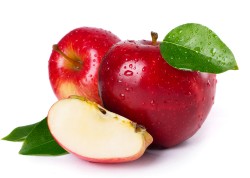 An apple consists of about 77% water, the rest belongs to dietary fiber (pectin and fiber
), organic acids, vitamins (A, B1, B3, ascorbic and nicotinic acids), macro- and microelements (potassium, calcium, iron, magnesium, phosphorus, sodium).
An apple consists of about 77% water, the rest belongs to dietary fiber (pectin and fiber
), organic acids, vitamins (A, B1, B3, ascorbic and nicotinic acids), macro- and microelements (potassium, calcium, iron, magnesium, phosphorus, sodium).
The most important role, according to scientific sources , belongs to pectin , which binds to a number of harmful substances (mercury, lead, cobalt, cholesterol) during digestion and promotes their excretion from the small intestine. Once in the end sections of the digestive tube, pectin is broken down by bacteria and absorbed.
Apples normalize the processes of fecal mass formation. They have been used since ancient times to treat constipation and diarrhea. To do this, it is enough to consume 1-2 ripe fruits in the morning for several days. Apples also stop the growth of cancer cells due to the antioxidant effect.
Apples are widely used in dietetics. They contribute to the rapid development of a feeling of fullness of the stomach, but contain few calories. This feature also leads to an increase in the volume of the stool and the elimination of fecal stones. Research is underway on the anti-inflammatory effect of apples.
3. Cereals
 Whole grain fibers (oats, wheat) improve digestive processes. Cereals have the following positive properties:
Whole grain fibers (oats, wheat) improve digestive processes. Cereals have the following positive properties:
- Eliminate constipation. Major meta-analysis showed that cereals not only eliminate fecal retention, but also normalize their consistency, as well as stool frequency. The effect is comparable to popular laxatives (for example, lactulose).
- Improve intestinal microbiocenosis. The components of dietary fiber (inulin, starch, oligofructose) are a nutrient medium for most beneficial microorganisms living in the human intestine.
4. Bran
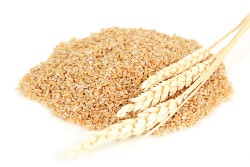 Bran, although it is a byproduct of grain processing, is important in the human diet.
Bran, although it is a byproduct of grain processing, is important in the human diet.
Bran, similar to whole grains, creates optimal living conditions for bacteria in the intestine, and also increases the mass of smooth myocytes, which has a positive effect on the motility of the digestive tube.
Scientific studies show that bran can bind to a large complex of toxic compounds and bile acids, removing them unchanged from the body. Such ballast substances are extremely important for the whole body, as they are involved in complex physiological processes.
Available compelling data relative to the fact that bran is able to prevent the development of hemorrhoids, pancreatitis, diabetes mellitus, dyslipidemia and even malignant diseases.
5. Beet
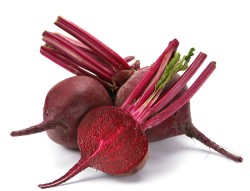 Beetroot contains betaine and betanin, which are involved in fat metabolism and normalize liver function
. Also beetroot
rich in fiber
, which stimulates the production of digestive juices, which accelerates
enzymatic processes
and increases the rate of progress of chyme in the lumen of the gastrointestinal tract.
Beetroot contains betaine and betanin, which are involved in fat metabolism and normalize liver function
. Also beetroot
rich in fiber
, which stimulates the production of digestive juices, which accelerates
enzymatic processes
and increases the rate of progress of chyme in the lumen of the gastrointestinal tract.
In addition, beetroot supports the growth of essential microorganisms. At the same time, the availability of a nutrient medium for bacteria is extremely high. For example , out of 136 g of beetroot in unchanged form, as much as 3.4 g of fiber reaches the large intestine, which is significantly more than most other plants.
The role of beetroot as a laxative and anti-inflammatory agent is currently being actively discussed. Clinical trials are underway regarding the feasibility of treating Crohn's disease with this vegetable.
6. Ginger
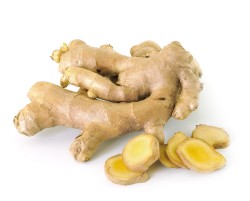 Ginger root is rich in vitamins and trace elements that have antiseptic properties (destroy pathogenic bacteria on the way to the stomach, are effective against helminths) and increase the activity of digestive enzymes (proven effect on lipase).
Ginger root is rich in vitamins and trace elements that have antiseptic properties (destroy pathogenic bacteria on the way to the stomach, are effective against helminths) and increase the activity of digestive enzymes (proven effect on lipase).
An important role is assigned to gingerol, which stimulates the secretion of bile into the lumen of the gastrointestinal tract (indicated for the treatment of biliary dyskinesia of the hypomotor type). The product also protects the mucous membrane from the effects of any aggressive substances.
Important properties are the elimination of dyspeptic disorders (nausea, vomiting, heartburn, feeling of fullness of the stomach) by accelerating the evacuation of food particles from the stomach. Ginger quickly eliminates the dysfunction of the gastrointestinal duodenal sphincter. Similar effects scientifically justified .
7. Lemon
 Lemons consist of about 10% carbohydrates, which are represented by simple sugars and soluble fibers
, contain a large amount of pectin.
Lemons consist of about 10% carbohydrates, which are represented by simple sugars and soluble fibers
, contain a large amount of pectin.
Lemon effectively outputs toxic substances are released from the intestine and slows down the absorption of various sugars and starch, which has a very favorable effect on the glycemic background. However, in order to benefit, it is necessary to consume the pulp, not the juice.
8. Green vegetables
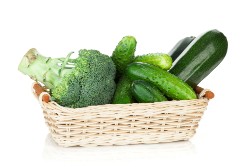 Green-colored vegetables (broccoli, spinach, Brussels sprouts) are a source of insoluble fiber
, which improves the motility of the intestinal tube and accelerates the passage of food within the normative speed indicators. This helps to eliminate constipation and accelerate metabolism.
Green-colored vegetables (broccoli, spinach, Brussels sprouts) are a source of insoluble fiber
, which improves the motility of the intestinal tube and accelerates the passage of food within the normative speed indicators. This helps to eliminate constipation and accelerate metabolism.
Green vegetables, according to American scientists are also rich in various trace elements, in particular magnesium, which increases the tone of smooth muscles, leading to faster excretion of feces.
Spinach has a separate set of properties. It is able to capture a number of toxic substances, including putrefaction products, and remove them from the body.
Sugar compounds, which are extremely abundant in leafy greens, create a favorable environment for the reproduction of beneficial flora. In addition, Brussels sprouts inhibit the processes of protein synthesis in pathogenic microorganisms.
9. Mango
 Mango is rich in digestive enzymes – amylases, which are involved in the breakdown of complex carbohydrates and increase the biological value of the food consumed. Mango is also rich in dietary fiber, therefore, it can be used for stool disorders such as constipation or diarrhea.
Mango is rich in digestive enzymes – amylases, which are involved in the breakdown of complex carbohydrates and increase the biological value of the food consumed. Mango is also rich in dietary fiber, therefore, it can be used for stool disorders such as constipation or diarrhea.
One of the major studies demonstrated that eating mango is much more effective than taking soluble fiber to treat long-term constipation.
10. Onions
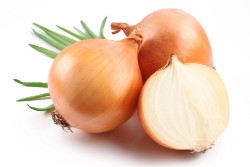 Onions have antibacterial properties. Proven
the effectiveness of onions in relation to E. coli and Pseudomonas aeruginosa, staphylococci. Onion's active ingredients damage cell walls and membranes, causing the destruction of unwanted cells.
Onions have antibacterial properties. Proven
the effectiveness of onions in relation to E. coli and Pseudomonas aeruginosa, staphylococci. Onion's active ingredients damage cell walls and membranes, causing the destruction of unwanted cells.
It is important to note that the experiment conducted in the laboratory showed an inhibitory effect against the bacterium Helicobacter Pylori, which infected almost 90% of the population. It is this particular microorganism that causes, according to the latest scientific data , the development of gastric ulcer.
Onion also forms a nutrient medium for beneficial bacteria in the intestine (especially for bifidobacteria and lactobacilli), strengthens the mucous membrane and increases the functional activity of local factors immunity . These features reduce susceptibility to infectious and inflammatory diseases of any etiology.
11. Nuts
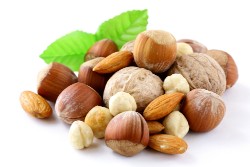 Canadian scientists claim that various nuts contain enormous amounts of insoluble fiber, which is indispensable for ensuring adequate digestion.
Canadian scientists claim that various nuts contain enormous amounts of insoluble fiber, which is indispensable for ensuring adequate digestion.
Nuts also contain many prebiotics that accelerate the development of "good" microorganisms and inhibit the vital activity of pathogenic flora.
High fiber content in the diet helps to reduce the calorie content of food, which is important for weight loss and treatment of cardiovascular diseases.
12. Peach
 Peach helps digestion due to its high fiber content, half of which is insoluble (there are 2 grams in 1 small fruit).
Peach helps digestion due to its high fiber content, half of which is insoluble (there are 2 grams in 1 small fruit).
According to the latest scientific data, peach can be used to eliminate constipation and normalize the motility of the smooth muscles of the gastrointestinal tract.
A large number of fatty acids can reduce the severity of inflammatory changes in the intestinal mucosa and improve the course of diseases such as irritable bowel syndrome, ulcerative colitis and Crohn's disease.
Peach blossoms deserve special attention. They are widely used in Chinese folk medicine in order to increase the frequency and strength of contractions of smooth myocytes of the digestive tube.
13. Sauerkraut
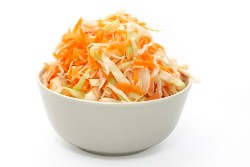 The fermentation product of cabbage, according to laboratory observations, contains a large number of microorganisms (especially lactobacilli) that normalize the microflora and intestinal peristaltic contractions. Amazing
, but in one serving of the dish (about 70 g) there are over 28 different stamps.
The fermentation product of cabbage, according to laboratory observations, contains a large number of microorganisms (especially lactobacilli) that normalize the microflora and intestinal peristaltic contractions. Amazing
, but in one serving of the dish (about 70 g) there are over 28 different stamps.
Probiotics of sauerkraut prevent the vital activity of harmful bacteria, reduce the absorption of various toxic substances, contribute to the suppression of autoimmune and inflammatory processes in the gastrointestinal tract.
The product also promotes the breakdown of complex fats and carbohydrates in the lumen of the gastrointestinal tract, which leads to faster and more complete absorption of nutrients.
7 "heavy" foods that Need to be limited
 Scientists identify a number of food products that are quite difficult to undergo fermentation processes and subsequent assimilation. With excessive consumption of such food, various digestive disorders can develop (from short-term constipation to exacerbation of chronic diseases).
Scientists identify a number of food products that are quite difficult to undergo fermentation processes and subsequent assimilation. With excessive consumption of such food, various digestive disorders can develop (from short-term constipation to exacerbation of chronic diseases).
Below are the 7 most difficult foods for digestion:
- Fried food. Fried foods (especially in oil) are quite difficult to digest due to the high volume of fats. It has been proven, for example, that the abuse of "fast food" containing a large number of nuggets and cutlets increases the risk of developing gastritis or insufficiency of the esophageal-gastric sphincter.
- Raw vegetables. Although most representatives of this group are useful for the body and improve digestive processes, they should not be abused. With an excess of dietary fiber, the motor activity of the stomach and small intestine is disrupted, and gas formation in the intestine increases.
- Acidic foods. Tomatoes, lentils, corn change the acid-base state of the contents of the digestive tube, leading either to inhibition of contractile activity or to the development of spastic constipation.
- Spicy food. This group contributes to damage to the mucous membrane of the gastrointestinal tract throughout its entire length. This leads to the development of symptoms of irritation (heartburn, pain) and exacerbation of any chronic pathologies.
- Beans. Is the leader in carbohydrate content. With simultaneous intake of 100 g of a legume plant, a short-term "collapse" of the intestine develops due to overload.
- Chocolate. The combination of a large number of vegetable fats with caffeine, as well as milk, leads to a weakening of all sphincters and the development of symptoms of their insufficiency (duodenal-gastric or gastroesophageal reflux).
- Freshly squeezed citrus juices. The composition contains a large number of components that irritate the mucous membranes and disrupt the work of protective barriers. When taking drinks on an empty stomach, the risk of developing peptic ulcer of the stomach and duodenum increases significantly.
Conclusion
Thus, it is necessary to consume more foods that have a beneficial effect on the gastrointestinal tract and the body as a whole. It is also important to reduce the content of substances in the diet that cause disruptions in the digestive tract and the development of various diseases.
